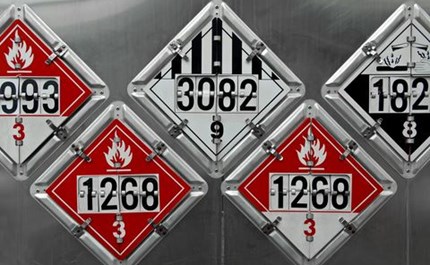Transportation of dangerous goods/h2>

�Transportation of dangerous goods/a>,, is a very responsible matter and necessarily requires compliance with a large volume of domestic and international rules. In Russia , this process is regulated by the following international agreements and internal legislative acts:/p>
- �UN Recommendations on the Transport of Dangerous Goods (document ST/SG/AC.10/Rev.18), 2013./li>
- �International Code for the Carriage of Dangerous Goods by Sea (IMDG Code), 2012./li>
- �European Agreement on the International Carriage of Dangerous Goods by Inland Waterways (ADN), 2015./li>
- �European Agreement on the International Carriage of Dangerous Goods by Road (ADR), 2015./li>
- �Rules for the International Carriage of Dangerous Goods by Rail (RID), 2015./li>
- �Technical Instructions for the Safe Transport of Dangerous Goods by Air (ICAO TI), 2015-2016./li>
- �Order of the Ministry of Transport of the Russian Federation No. 262 dated 05.09.2016 "On Amendments to the Rules for Ensuring the Safety of Passenger and Cargo Transportation by Road and Urban Ground Electric Transport, Approved by Order of the Ministry of Transport of the Russian Federation No. 7 dated January 15, 2014, and Invalidation of Certain Regulatory Legal Acts of the Ministry of Transport of the Russian Federation"/li>
�In addition, there are separate GOST standards definingspan class="mytool">�marking requirements/a> and packaging of dangerous goods:/p>
�The main regulatory documents for the transportation of dangerous goods by sea are:br />�International Code for the Carriage of Dangerous Goods by Sea (RID MC)./a> �When developing a route and calculating the cost of transportation, it is important to take into account the need for additional securing of cargo, carrying out loading and unloading operations with extreme caution and the possibility of providing special equipment.br />�The movement of dangerous goods by rail is regulated by the Agreement on International Rail Freight Traffic (SMGS), the Convention on International Carriage by Rail (COTIF), the Rules for the International Carriage of Goods by Rail (RID), regulations of individual States and Commonwealth./p>
�There are the following features of the transportation of dangerous goods: a vehicle for the transportation of dangerous goods must be ordered in advance (usually 2-3 working days from the expected date of transportation); for the transportation of dangerous goods, it is necessary to prepare emergency cards, which are compiled on the basis of the Passport of the substance, as well as route sheets, which indicate the routes of transportation of dangerous goods./p>
�The driver must strictly adhere to the routes indicated in the itinerary; it is necessary to prepare accompanying documents for the transportation of dangerous goods: certificates, passport of the substance, TTN, invoices. As a rule, it takes 3-5 days to formalize and coordinate the route of transportation of dangerous goods; when transporting dangerous goods, it is necessary to observe the speed limit, therefore, high-speed ADR cargo transportation is not allowed; some groups of dangerous goods are allowed to be transported together; when loading, unloading, and also when transporting dangerous goods, the driver is responsible, in connection with with what he has the right not to acceptspan class="mytool">�cargo/a> ADR for transportation in case the accompanying documentation is incorrectly or incorrectly issued, the rules for the transportation of dangerous goods are not observed, the packaging is damaged or deformed./p>
�Danger signs are applied: on packages having the form of a parallelepiped (including containers and packages), on the side, end and upper surfaces: on barrels - on one of the bottoms and on the shell on two opposite sides; on bags - in the upper part at the seam on both sides; on bales and bales - on the end and side surfaces./p>
�The consignment note must be written in the official (state) language of the shipper. If this language is not English, French, German, then additionally in one of these languages./p>
�When writing the name of the dangerous goods being transported in the consignment note, the identification number UN ... (or ANO...) is indicated first (for example, UN 1256)./p>
�Then the full name of the dangerous cargo is recorded (for example, nitric acid)./p>
�Then the main hazard class is indicated (the number of the main hazard sign is called) and, if there is, the additional hazard class (in parentheses) (the number of the additional hazard sign is called) - 8 (6.1), and the packing group is also indicated, if there is one - I./p>
�Example of a complete entry: UN 1256, nitric acid, 8 (6.1), I./p>
�The packaging form, quantity and weight are written in words, for example: UN 1256, nitric acid, 3, III (barrels, 10 pieces, 2000 kg)./p>
�Empty and uncleaned packages are examples:/p>
�Empty barrels, 3 (6.1).br />�Empty tanker truck, last load UN 1230, methanol, 3 (6.1), II.br />�Empty tanker truck, last cargo UN 1203, gasoline, 3, II.br />�These entries can be made by the car driver himself in any place of the copy of the invoice of the last cargo. These entries are required./p>
�Transportation of dangerous goods by sea/h3>
�International Convention for the Prevention of Pollution from Ships (MARPOL 73/78)./a>
�International Convention for the Safety of Life at Sea (SOLAS 74)./a>
�Normative acts of individual states.br />�On the basis of regulatory legal acts of the federal level, rules and instructions for handling dangerous goods have been developed and approved, where all control procedures, safe transportation during multimodal cargo transportation, storage and transshipment in seaports are clearly regulated. According to Russian laws, vessels with documents in accordance with the Rules for the Carriage of Dangerous Goods by Sea (the Rules of the MOPOG) are allowed to transport dangerous goods./p>
�Transportation of dangerous goods by rail/h3>
�Features of transportation of dangerous goods by motor transport/strong>
�Registration of TTN/strong>
- Government Resolution No. 778 dated 07/06/2018/span>
- Which goods are declared as one product/span>
- Government Resolution No. 2240 dated 07.12.2022/span>
- What is required for DS according to TR CU 009/2011/span>
- What is required for CC or DS according to TR CU 004/2011/span>
- What is required for CC or DS according to TR CU 020/2011/span>
- Customs control of the value of goods/span>



